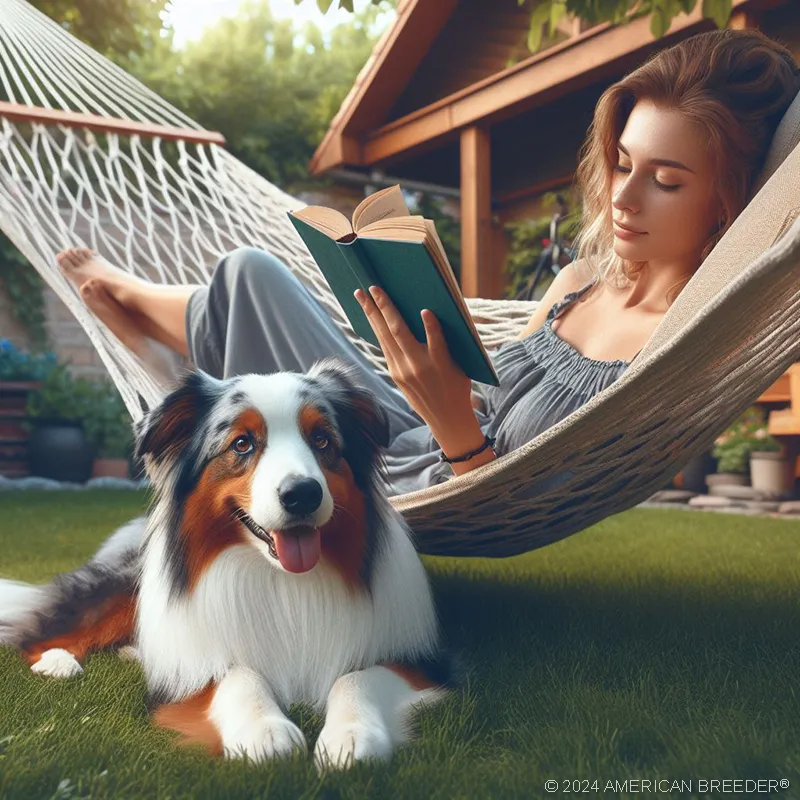Discovering the Australian Shepherd Dog Breed
 The Australian Shepherd Dog, a breed known for its intelligence, agility, and unwavering loyalty. This guide has been meticulously crafted to provide you with in-depth insights into every aspect of this remarkable breed. Whether you're a prospective owner, a seasoned enthusiast, or just curious about Australian Shepherds, this guide will equip you with the knowledge you need to understand, care for, and appreciate these wonderful dogs.
The Australian Shepherd Dog, a breed known for its intelligence, agility, and unwavering loyalty. This guide has been meticulously crafted to provide you with in-depth insights into every aspect of this remarkable breed. Whether you're a prospective owner, a seasoned enthusiast, or just curious about Australian Shepherds, this guide will equip you with the knowledge you need to understand, care for, and appreciate these wonderful dogs.
Introduction to the Australian Shepherd
The Australian Shepherd, often referred to as the "Aussie," is a breed renowned for its striking appearance and exceptional intelligence. Despite the name, Australian Shepherds did not originate in Australia but rather in the United States. These dogs were initially bred for herding livestock, and their boundless energy and strong work ethic are still prevalent traits today. Aussies are highly versatile and excel in various roles, from herding to agility competitions.
Australian Shepherds have a distinctive appearance characterized by their expressive almond-shaped eyes, a lush double coat that comes in various colors and patterns, and a natural bobtail. Their medium-sized, well-proportioned bodies exude strength and athleticism.
Breed Background and History
To truly understand the Australian Shepherd, it's essential to delve into their rich history. These dogs are believed to have descended from the Basque Shepherd Dogs that accompanied shepherds from Europe to Australia and then to the United States in the 1800s. Their name might be misleading, but their American roots run deep.
 Australian Shepherds played a pivotal role in the development of ranching and herding in the American West. They became indispensable working partners for cattle ranchers due to their herding instincts and adaptability. Over time, these dogs gained recognition for their exceptional skills and gradually found their way into the hearts of dog lovers across the nation. As Australian Shepherds became more popular, their breed standard evolved, and they were officially recognized by the American Kennel Club (AKC) in 1993. Today, they are celebrated not only for their herding abilities but also as loving family pets and skilled competitors in dog sports.
Australian Shepherds played a pivotal role in the development of ranching and herding in the American West. They became indispensable working partners for cattle ranchers due to their herding instincts and adaptability. Over time, these dogs gained recognition for their exceptional skills and gradually found their way into the hearts of dog lovers across the nation. As Australian Shepherds became more popular, their breed standard evolved, and they were officially recognized by the American Kennel Club (AKC) in 1993. Today, they are celebrated not only for their herding abilities but also as loving family pets and skilled competitors in dog sports.
Appearance and Characteristics
Australian Shepherds are known for their striking appearance and unique features. Their eyes, in particular, are captivating. Aussies often have mesmerizing eyes with shades of blue, brown, or even one of each, creating a soulful and expressive gaze. These dogs are of medium size, with well-defined muscular bodies that exude athleticism and strength. Their coat is double-layered, with a weather-resistant outer layer and a soft, insulating undercoat.
Their coat comes in various colors, including black, red, blue merle, and red merle, with combinations of white and tan markings. The merle patterns in their coat create a marbled or speckled effect, adding to their visual appeal. Additionally, Australian Shepherds have a natural bobtail or a tail that is docked to a short length, adding to their distinctive appearance. The average height of an Australian Shepherd ranges between 18 to 23 inches (46 to 58 cm), and they typically weigh between 40 to 65 pounds (18 to 29 kg). Their physical characteristics, including their coat and tail, are a testament to their adaptability and efficiency as working dogs.
Temperament and Personality
The Australian Shepherd is not just a pretty face; their temperament and personality are equally captivating. Aussies are renowned for their intelligence, loyalty, and boundless energy. They are quick learners and thrive when provided with mental stimulation and physical activity. These dogs are highly attuned to their owners' emotions and often form strong bonds with their families.
 Australian Shepherds are not only affectionate but also protective, making them excellent watchdogs. They are known to be reserved around strangers but warm up quickly to those they trust. Their herding instincts are still deeply ingrained, and they may exhibit behaviors like nipping at heels, which can be redirected through training. It's important to note that their intelligence can sometimes lead to stubbornness, and they require consistent training and socialization from a young age. Aussies are not well-suited for a sedentary lifestyle; they thrive in active households that can provide them with both mental and physical challenges.
Australian Shepherds are not only affectionate but also protective, making them excellent watchdogs. They are known to be reserved around strangers but warm up quickly to those they trust. Their herding instincts are still deeply ingrained, and they may exhibit behaviors like nipping at heels, which can be redirected through training. It's important to note that their intelligence can sometimes lead to stubbornness, and they require consistent training and socialization from a young age. Aussies are not well-suited for a sedentary lifestyle; they thrive in active households that can provide them with both mental and physical challenges.
Trainability and Intelligence
Australian Shepherds are often regarded as one of the most intelligent dog breeds, which makes them highly trainable. Their intelligence, combined with their eagerness to please their owners, makes training sessions enjoyable and effective. Whether you're teaching basic commands or advanced tricks, Aussies are quick to catch on.
However, their intelligence can be a double-edged sword. Without proper mental stimulation, they may become bored and resort to destructive behaviors. It's essential to provide them with tasks that engage their minds, such as puzzle toys and obedience training. Aussies excel in various dog sports and activities, including agility, herding trials, and obedience competitions. Their versatility and trainability make them a popular choice among dog enthusiasts looking for a partner in competitive endeavors.
Practical Considerations
Before bringing an Australian Shepherd into your life, there are several practical considerations to keep in mind. These dogs are not suited for every living situation. They thrive in homes with ample space to roam and play, so a large, securely fenced yard is ideal. Australian Shepherds have grooming needs that require regular attention. Their double coat sheds year-round, and brushing is necessary to manage shedding and prevent matting. Additionally, their ears should be checked and cleaned regularly, and their nails trimmed as needed.
 In terms of diet, Australian Shepherds benefit from a balanced and high-quality dog food that meets their specific nutritional needs. Portion sizes should be adjusted according to their age, activity level, and size. It's essential to consult with your veterinarian for guidance on the best diet for your Aussie.
In terms of diet, Australian Shepherds benefit from a balanced and high-quality dog food that meets their specific nutritional needs. Portion sizes should be adjusted according to their age, activity level, and size. It's essential to consult with your veterinarian for guidance on the best diet for your Aussie.
Health and Care
Understanding the health and care needs of your Australian Shepherd is crucial for ensuring a happy and long life for your furry companion. Like all breeds, Aussies can be prone to certain health issues, and proactive care can mitigate potential problems.
One of the common concerns in Australian Shepherds is hip dysplasia, a genetic condition where the hip joint doesn't develop properly. Regular veterinary check-ups, especially during puppyhood, can help identify and manage this condition early. In addition, eye problems, including cataracts and progressive retinal atrophy (PRA), can affect Aussies, making regular eye exams essential. Responsible breeders often conduct health screenings on their breeding dogs to reduce the risk of hereditary conditions. When getting an Australian Shepherd puppy, ask the breeder about these health clearances to ensure the puppy's genetic health.
Exercise and Activity
Australian Shepherds are high-energy dogs that thrive on physical activity and mental stimulation. Daily exercise is a must to keep them happy and healthy. Activities like fetch, agility training, hiking, and even herding trials are excellent ways to expend their energy. Interactive toys and puzzle feeders can also provide mental challenges, preventing boredom. Keep in mind that Australian Shepherds are happiest when they have a job to do, so engaging them in activities that tap into their herding instincts can be highly rewarding for both you and your dog.
 Failure to provide adequate exercise and mental stimulation can result in behavioral problems, such as excessive barking or destructive behavior. Investing time in your Aussie's physical and mental well-being is a crucial part of responsible ownership.
Failure to provide adequate exercise and mental stimulation can result in behavioral problems, such as excessive barking or destructive behavior. Investing time in your Aussie's physical and mental well-being is a crucial part of responsible ownership.
Socialization and Interaction
Socialization is a vital aspect of raising a well-adjusted Australian Shepherd. Exposing your dog to different people, animals, and environments from a young age helps them become confident and friendly adults. Puppy classes and obedience training are excellent opportunities for socialization.
It's important to note that Australian Shepherds can be reserved around strangers due to their protective nature. Proper socialization can help them differentiate between friend and foe, reducing any excessive guarding behaviors. Remember that socialization is an ongoing process. Regular exposure to new experiences throughout their life will help your Aussie remain well-adjusted and adaptable.
Australian Shepherds as Family Dogs
Australian Shepherds can make wonderful family pets when their needs for exercise, mental stimulation, and companionship are met. They are known for their loyalty and affection toward their human family members, making them excellent companions for children. However, their herding instincts may lead them to try to "herd" children or other pets in the household, which can include nipping or barking. Early training can help channel these behaviors appropriately.
 Keep in mind that while Australian Shepherds are great with children, their energy level can sometimes be overwhelming for very young kids. Supervision and teaching children how to interact appropriately with the dog are essential.
Keep in mind that while Australian Shepherds are great with children, their energy level can sometimes be overwhelming for very young kids. Supervision and teaching children how to interact appropriately with the dog are essential.
Conclusion
In conclusion, the Australian Shepherd is a remarkable breed known for its intelligence, agility, and unwavering loyalty. Their striking appearance, coupled with their affectionate yet protective nature, makes them a beloved choice for dog enthusiasts. To ensure a happy and fulfilling life for your Australian Shepherd, it's crucial to meet their physical and mental needs through regular exercise, training, and socialization. Proper grooming and veterinary care also play a vital role in keeping your Aussie healthy and happy.
Whether you're considering adding an Australian Shepherd to your family or you're already a proud owner, this comprehensive guide aims to equip you with the knowledge and insights necessary to provide the best possible care for your furry friend. With dedication, patience, and love, you can enjoy a rewarding journey with your Australian Shepherd companion.
Remember, every Australian Shepherd is unique, and the bond you share with your dog will be a one-of-a-kind experience. Cherish every moment with your Aussie, and they will undoubtedly fill your life with joy and laughter. We hope this guide serves as a valuable resource on your journey with the Australian Shepherd breed, and we wish you many happy adventures with your loyal and loving companion.
Australian Shepherd Dog Quick Reference Guide
Breed Background: Origin: United States | Breed Purpose: Herding | AKC Class: Herding Group | Year Recognized by AKC: 1993
Appearance: Size: Medium | Weight: 40-65 pounds | Coat Type: Double Coat | Colors & Patterns: Various | Distinctive Features: Tri-color Coat, Bobbed Tail Temperament: Energy Level: 4/5 | Friendliness to Pets: 4/5 | Friendliness to Strangers: 3/5 | Trainability: 5/5 | Playfulness: 5/5 | Frequent Barker: 2/5 | Chase Instincts: 5/5 | Sense of Smell: 3/5 | Drive to Hunt: 3/5
Temperament: Energy Level: 4/5 | Friendliness to Pets: 4/5 | Friendliness to Strangers: 3/5 | Trainability: 5/5 | Playfulness: 5/5 | Frequent Barker: 2/5 | Chase Instincts: 5/5 | Sense of Smell: 3/5 | Drive to Hunt: 3/5
Health & Care: Health Issues: Hip Dysplasia, Eye Conditions | Lifespan: 12-15 years | Grooming Difficulty: Moderate | Exercise Needs: High
Socialization: Interaction with Children: Good with Supervision | Interaction with Pets: Generally Friendly | Interaction with Strangers: Reserved | Ease of Training: Easy
Suitable Living Arrangements: Apartment: No | House: Yes | Rural Area: Yes | Yard Size Requirements: Large Yard
Training & Obedience: Trainability: 5/5 | Intelligence: 5/5 | Obedience: 4/5 | Problem-Solving: 4/5 | Easily Stimulated: 4/5 | Focus Level: 4/5 | Easily Distracted: 3/5
Financial Planning: Typical Price Range: -$$$ | Initial Expenses: Vaccinations, Microchipping | Ongoing Annual Expenses: Food, Grooming, Veterinary Care
Breeding: Reproductive Maturity: 18-24 months | Litter Frequency: 1-2 per year | Litter Size: 6-9 puppies | Stud Cost: -$$$ | Breeding Challenges: Proper Genetic Testing
